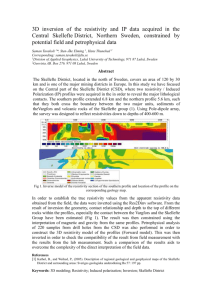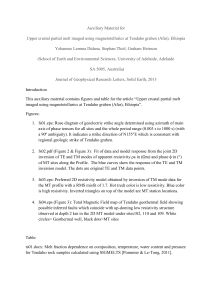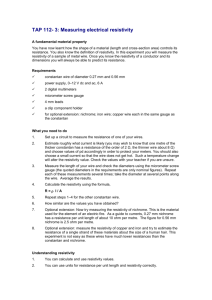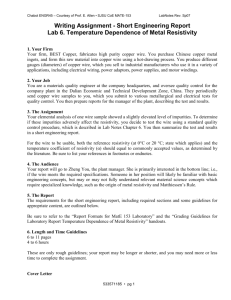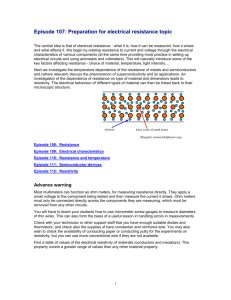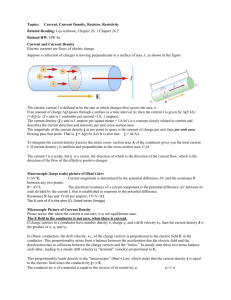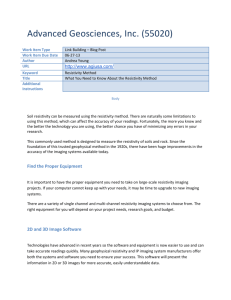Resistivity
advertisement
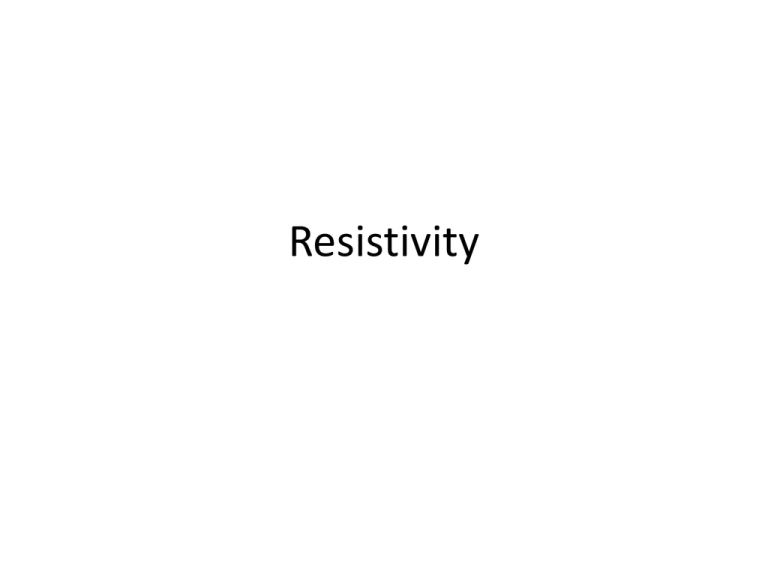
Resistivity Learning objectives • • • • • • • • Candidates should be able to: (a) define resistivity of a material; (b) select and use the equation (c) describe how the resistivities of metals and semiconductors are affected by temperature; (d) describe how the resistance of a pure metal wire and of a negative temperature coefficient (NTC) thermistor is affected by temperature Resistivity or Resistance • They’re different things. Resistivity is a property of a material so copper will have a different resistivity to iron for example definition • The resistivity ρ of a wire of length l, resistance R and area of cross-section A is given by • Ρ=RA l How do we know? • Resistance is proportional to length • Resistance is inversely proportional to crosssectional area Can you work out the units Units • Ωm The effect of temperature on resistivity • If we heat up a metal the internal energy of the atoms also increases. • This could be down to either potential energy or kinetic energy Potential or kinetic • When you heat up a metal it will expand (before it eventually melts) but only a comparatively small amount. • Therefore the atoms have gained very little extra space so it isn’t a gain in potential energy. • So it must be that heating a metal causes an increase in kinetic energy Kinetic energy • As we heat a metal the atoms within it start to vibrate more. • Conduction electrons moving through this are more likely to bang into one of these moving atoms. • This means that the increase in temperature increases the resistance. • In fact the resistance is directly proportional to the temperature in Kelvin How does this affect resistivity • Well expansion will slightly increase both length and cross-sectional area. • This means that with the minimal effect of temperature the resistivity must be also increasing (proportionally) with temperature. Semiconductors - Thermistors • These are made from silicon to which a small impurity of other atoms. • This means that when temperature is increased it has a much greater affect on the resistance. NTC • These impurity atoms help with conduction • The resistance actually reduces as temperature increases. • It is therefore said to have a negative temperature coefficient. • (This is because the increase in temperature releases more conduction electrons to transmit the electricity). • An NTC can have a resistance of 9000Ω at 0⁰C and of 240 Ω at 100 ⁰C • • • • • • • • • • • Candidates should be able to: (a) describe power as the rate of energy transfer; (b) select and use power equations P = VI, P=I 2R and V2=P R (c) explain how a fuse works as a safety device (d) determine the correct fuse for an electrical device; (e) select and use the equation W = IVt; (f) define the kilowatt-hour (kW h) as a unit of energy; (g) calculate energy in kW h and the cost of this energy when solving problems. Power • We have already seen that V=IR • And P=IV • Provided that we are applying this to one part of a circuit we can do some combining so P=IV, V=IR • So P = I (IV) = I2R • Also I= V/R • So P = (V/R) V = V2/R • These are all work outable in an exam but why waste the time. LEARN THEM We can also work out energy • • • • • By multiplying power by time So W = Vit W = I2Rt W=tV2/R Fuses • Made from thin copper wire. • Low resistivity • Because the wire is thin it’s resistance causes the wire to melt if the current passing through it is too high • This breaks the circuit if the current is too high From GCSE • The fuse needs to be one which is rated just over the normal maximum current used by the device. • This maximum normal current is calculated by P=IV Circuit breakers • Electromagnetic switches which are triggered when the system is overloaded • Cables deliver 60A at 230V. So what is the power? The kilowatt hour • If we worked out how many joules of energy was used in a home the number would be massive. • A 60W bulb uses 60J every second. • Instead we use a bigger value of power (the kilowatt) and time (the hour) • Therefore Energy = Power x time • So kilowatt x hour = the kilowatt hour




